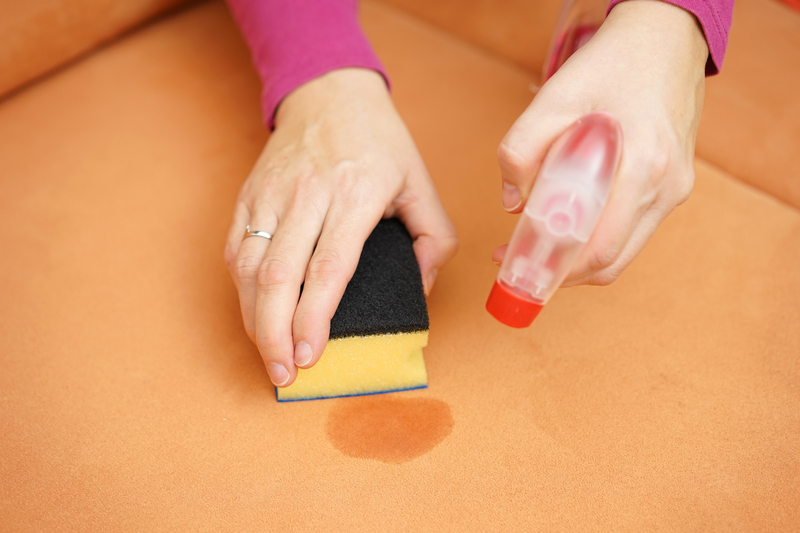Step-by-Step to a Mold-Free Bathroom Space
Posted on 23/09/2025
Step-by-Step to a Mold-Free Bathroom Space: Comprehensive Guide
Mold infestations in bathrooms are a common homeowner's nightmare. High humidity, poor ventilation, and frequent exposure to water create the perfect breeding ground for mold spores. If you're tired of fighting persistent mildew or worried about the health risks associated with mold growth, you're not alone. In this comprehensive, SEO-optimized article, we'll guide you step-by-step to create a completely mold-free bathroom and keep it that way for the long term.

Why Is Mold Prevention Essential in Bathrooms?
Mold not only looks unsightly but can also harm your health by releasing allergens and irritants. The bathroom, with its moisture-rich environment, provides the perfect conditions for mold and mildew to thrive. Preventing mold in the bathroom safeguards your family's well-being and protects your home's structural integrity. Plus, a mold-free bathroom is simply more inviting!
- Health Risks: Mold exposure can trigger asthma attacks, respiratory irritation, and allergic reactions.
- Damage: Mold can weaken tiles, drywall, and grout, leading to expensive repairs.
- Odor: Musty smells from mold can persist even after cleaning.
Understanding the Causes of Bathroom Mold
Before you can achieve a mold-free bathroom environment, it's crucial to understand what causes mold outbreaks in the first place:
- Excess moisture from showers, baths, and sinks
- Poor ventilation that allows steam to linger
- Leaky plumbing or fixtures
- Neglected cleaning routines and soap buildup
- Cool surfaces (mirrors, tiles) where condensation forms
Step-by-Step to a Mold-Free Bathroom Space
Step 1: Assess & Identify Mold-Prone Areas
Begin your mission to a mold-free bathroom by identifying risky zones. Mold often thrives in:
- Tile grout and caulking
- Shower curtains and liners
- Under the sink and around plumbing fixtures
- Behind toilets and around windowsills
- Ceilings and walls near bathtubs or showers
Tip: Check for discoloration, a musty odor, or water spots. Early detection avoids widespread contamination.
Step 2: Deep Clean Existing Mold
If you've noticed any existing mold or mildew, it's crucial to remove it immediately before implementing ongoing prevention methods for a mold-free bathroom space.
- Wear protective gear: Use gloves, a mask, and safety goggles.
- Use Effective Cleaners: Spray moldy areas with a solution of white vinegar, hydrogen peroxide, or a commercial mold remover (avoid mixing chemicals).
- Scrub Thoroughly: Use a stiff brush to scrub visible mold from tiles, grout, and other surfaces.
- Rinse and Dry: Wipe the area clean and ensure it is completely dry. Moisture left behind invites mold back.
Important: If mold covers more than 10 square feet, consider professional remediation--it could indicate a deeper problem behind walls or flooring.
Step 3: Control Humidity with Adequate Ventilation
Humidity is the top reason bathrooms grow mold. To achieve and maintain a mold-free bathroom, keep it dry and well-ventilated:
- Install an Exhaust Fan: Run it during and after showers for at least 20 minutes to vent excess steam.
- Open Windows: If possible, crack a window open during or after bathing to allow moisture to escape.
- Use a Dehumidifier: In high-humidity climates, a portable bathroom dehumidifier can make a big difference.
Pro Tip: Keep your exhaust fan clean! Dust and lint can block airflow and reduce effectiveness.
Step 4: Waterproof and Repair
The right materials and timely repairs are crucial for a permanently mold-free bathroom. Pay attention to these repair and waterproofing steps:
- Repair Leaky Pipes and Faucets: Even small drips cause hidden moisture build-up and attract mold.
- Re-caulk Showers and Sinks: Worn or cracked caulking allows water to seep behind tiles and into walls. Remove old caulk and apply a mold-resistant replacement.
- Seal Grout Lines: Use a grout sealer to prevent water penetration and keep tiles mold-free.
- Upgrade Problem Surfaces: Consider replacing porous surfaces with mold-resistant materials--such as fiberglass shower walls, glass doors, or mildew-resistant paint.
Step 5: Incorporate Daily Mold-Prevention Habits
Prevention is the secret to a lifelong mold-free bathroom. Make these simple habits part of your bathroom routine:
- Wipe Down Wet Surfaces: After every shower or bath, use a squeegee or towel to dry tiles, glass, and fixtures.
- Hang Towels and Bathmats to Dry: Don't leave them bunched up on the floor; damp textiles support mold growth.
- Launder Shower Curtains and Liners: Wash them regularly to prevent soap scum and mildew.
- Leave the Door Ajar: This allows air circulation and faster drying post-shower.
- Keep Toiletries Organized: Mold can grow underneath bottles and containers left in shower corners.
Step 6: Adopt a Regular Cleaning Schedule
Consistency is key to a mold-free space. Schedule a weekly cleaning routine and use products that prevent mold and mildew:
- Use Mold-Proof Cleaners: Look for bathroom sprays specifically designed to target fungus.
- Scrub Grout and Corners: Don't neglect hidden or hard-to-reach spots where mold often begins.
- Disinfect Drains: Pour a solution of vinegar and baking soda down the drain to prevent mold and odor buildup.
Step 7: Monitor and Inspect Frequently
Vigilance is your best defense. Inspect key areas regularly for early signs of moisture or mold accumulation:
- Behind and under sinks
- Under bathroom rugs
- Ceiling and wall corners
- Inside cabinets and storage closets
If you notice persistent dampness or a musty smell, act fast! Early intervention can stop mold before it spreads.
Extra Strategies for a Mold-Free Bathroom
Choose Mold-Resistant Products
- Mold-resistant drywall: Also known as "green board" or cement board, it's specially designed for damp environments.
- High-quality paint: Use bathroom-grade, mildew-resistant paints for walls and ceilings.
- Non-porous materials: Glass, porcelain, and sealed tile surfaces discourage mold from taking hold.
- Mildew-resistant caulk and sealants: These last longer and resist staining compared to traditional products.
Upgrade Bathroom Fixtures
- Swap shower curtains for glass doors that are easy to clean and dry.
- Install a higher-CFM exhaust fan if steam lingers too long.
- Consider touchless faucets that reduce water puddles around sink areas.
Natural Remedies for Mold-Free Bathrooms
If you prefer eco-friendly solutions for a mold-free bathroom space, try the following natural approaches:
- White vinegar: An effective, non-toxic mold killer--spray problem areas daily.
- Baking soda: Mix with water to scrub tiles and neutralize odors.
- Tea tree oil: Add a few drops to a spray bottle with water for potent, natural mold fighting.
Essential Oils Blend (DIY Mold Spray)
- Mix one cup of distilled water, one cup of white vinegar, and 10 drops of tea tree or lavender oil in a spray bottle.
- Spray liberally onto problem areas and leave to dry for a fresh-smelling, mold-free bathroom.

FAQs About Maintaining a Mold-Free Bathroom
How often should I clean my bathroom to keep it mold-free?
Ideally, give your bathroom a thorough cleaning once a week, focusing on potential trouble spots like grout, tiles, and drains.
What's the best way to ventilate a windowless bathroom?
Install a high-quality exhaust fan, leave the door open after bathing, and use a portable bathroom dehumidifier. Consider an air purifier to improve air quality further.
Is black mold in bathrooms dangerous?
While not all black mold is toxic, significant growth can produce harmful spores. If you suspect toxic black mold, call professionals immediately.
How do I prevent mold behind tiles or walls?
Waterproof surfaces using vapour barriers and proper tile installation. Repair leaks swiftly, and re-caulk or seal grout as needed to prevent hidden mold buildup.
Conclusion: Enjoy a Fresh, Mold-Free Bathroom Space
Mold doesn't have to be a fixture in your bathroom's design. By following our step-by-step process--identifying problem areas, eliminating existing mold, boosting ventilation, waterproofing, and building smart daily habits--you can consistently enjoy a clean, safe, and mold-free bathroom.
A mold-free bathroom space boosts your wellness, streamlines cleaning routines, and even adds value to your home. With a proactive approach and the strategies outlined above, you can say goodbye to bathroom mold, for good!
Ready for a Mold-Free Upgrade?
If you're planning a bathroom remodel or want professional advice for chronic mold problems, consider consulting a mold remediation expert. Prevention is always easier (and less expensive) than remediation.
Remember: Diligence, maintenance, and proper ventilation are your best tools for ensuring a mold-free, sanctuary-like bathroom for years to come.
- Act today for a healthier, happier home.
- Set your cleaning schedule and invest in proper bathroom upgrades--your future self will thank you!



